Jersey Knit Dress Sewing Tutorial – Learn how to sew a dress in a knit fabric as opposed to a woven fabric using a conventional sewing machine rather than a serger. This peasant dress tutorial also includes easy tips on how to use a printed fabric so that the fabric design and the dress pattern enhance each other
This is a guest post written by my amazing step-mother Harriette.
She is my go-to for anything and everything related to sewing. She has made so many beautiful things for our family that I asked her to share how she does it.
Her tutorial also includes some things she has learned about how to use a printed fabric so that the fabric design and the dress pattern enhance each other.
I love how she always presents each item she sews as a work of art. I can’t tell you how many times someone has asked where we “got” her amazing gifts.
Many people ask her how she does it, and now she is revealing her secrets to you!
Related: How to Sew a Pocket Pet Mouse
She has made several of these peasant dresses for my daughter. They are cute, functional, and can last for years in the wardrobe of a quickly growing child.
The dresses that were first made for my daughter have become tunics and dresses over time.
All you need to do is change out the elastic in the neck and arms over time to accommodate your child’s changing size and one of these dresses can last for 5 to 6 years in our experience so far!
Related: How to Teach a Child to Sew with Burlap and Yarn
How to a Sew Peasant Dress Made with Jersey Knit Fabric
I started sewing when I was very young, using commercial sewing patterns and fabrics that needed ironing.
For this peasant dress, I downloaded a template for the pattern from the internet and used an organic jersey knit fabric.
The best formula for assembling this dress:
- SLEEVES – attach to the Front
- SLEEVES – attach to the Back
- SIDE / UNDER ARM SEAMS
- CASING – for neck
- CASINGS – for sleeves
- HEM
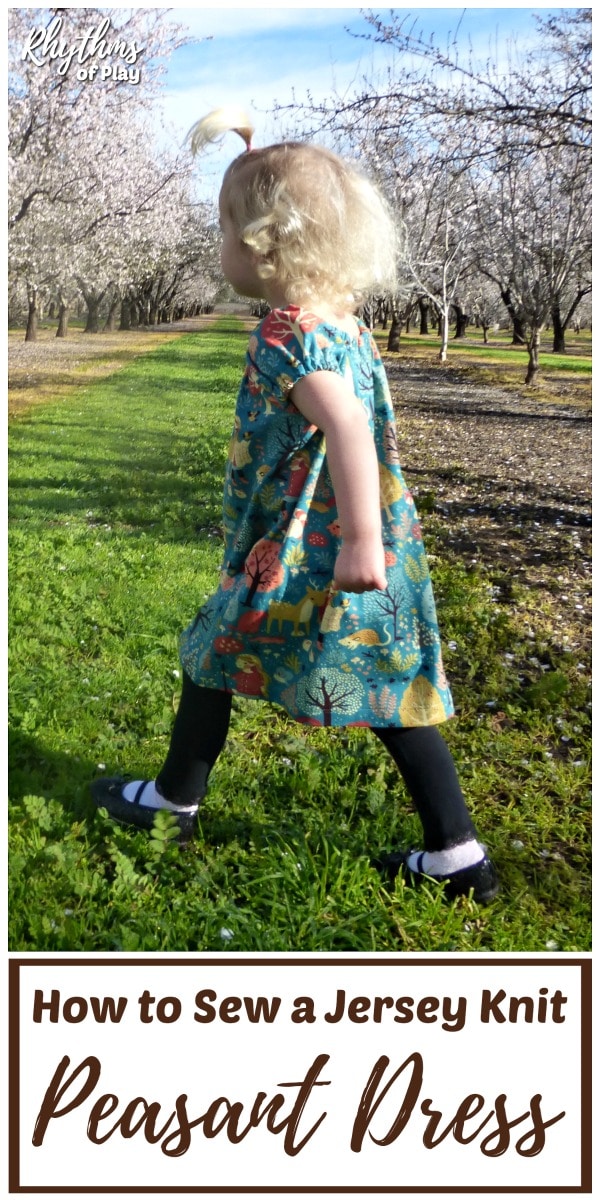
Related: How to Sew a Button Apple Tree
Jersey Knit Peasant Dress Materials
- Standard sewing machine (not a serger)
- Cotton jersey
- tracing paper
(for pattern making and cutting)
- Clear gridded ruler
- marker
- fabric scissors
- Thread & bobbin
- Universal sewing machine needle (size 90)
- 1/4″ wide elastic
- Fusible bias or knit tape (straighten curly fabric edges, interface hem edge)
- Personalized cloth name tag
or clothing label
(optional)
Peasant Dress Pattern:
- Go visit Scattered Thoughts of a Crafty Mom and download the peasant dress pattern. (The link to the pattern download is contained within the “materials” section of her post.)
- Print out the pattern
- Tape pages together
- Trace the size you need (Sizes 12 Months to 8 years are available)
The shape of the sleeve is confusing, so here is a closeup of my notes showing what’s what.
Working with Jersey Knit Fabric:
I used an organic cotton jersey called ‘Nature Hike‘ from Honey be Good. The design shows two scenes repeated alternately: the little girl gathering her woodland friends together, and then leaning them on a hike. I decided to use the vignette of the hike for the center front of the dress.
This fabric has a one-way design, meaning a right-side up and an upside-down direction. When you lay out the pattern on such a fabric, make sure the top of the fabric’s design will be at the neckline of the dress.
PRESHRINK THE FABRIC before cutting out the garment
Washing and drying the fabric the same way the garment will be laundered ensures that any inevitable shrinking takes place without affecting the fit.
Some knits curl along their cut edges when they are laundered; if this happens you either have to cut off the curly edge or flatten it out in order not to lose valuable fabric. I used fusible tape on the sample pictured below in order to flatten out the edges.
Some knits curl along their cut edges when they are laundered; if this happens you either have to cut off the curly edge or flatten it out in order not to lose valuable fabric. I used fusible tape on the sample pictured below in order to flatten out the edge.
NOTE: Place fusible products glue side against the fabric being interfaced, or expect a sticky sole plate.
* All fabric–both knit and woven–has a length and a width. The length (called ‘straight of grain’) is stronger, the width is stretchier.
Cutting the Fabric:
- Fold the fabric lengthwise on the grain, right sides together. Place the fold line marked on the pattern on the fold of the fabric.
- Cut around the pattern piece holding it down with pattern weights (pinning the pattern to the fabric can result in distortion of the shape), or draw around it and then cut on the line.
If your fabric design is uni-directional, the pattern pieces for the Front and Back can be placed on the fabric side by side, top to bottom, as shown in the photo below, with nothing destined to be upside down. This can help conserve fabric.
In the case of this size 3T version, you will need only a 22” length for the front and back. You need another 1/4 yd for the sleeves; you can use a contrasting fabric if desired.
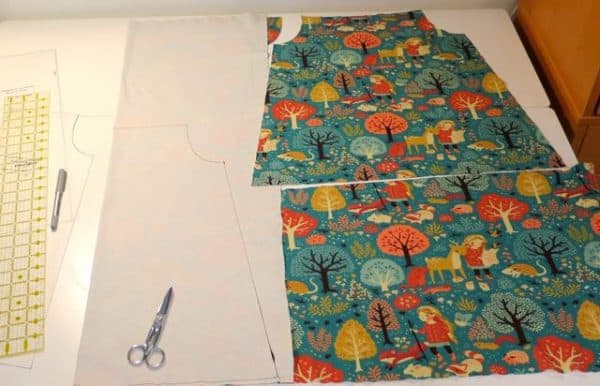
Mark the center of the Back at the hem for placement of the name tag or label, on the inside of the fabric; placing the name tag at the hem prevents any irritated skin it might cause if placed at the neck. Mark center back at the neck also.
Related: Love Birds Softie Beginning Sewing Tutorial with FREE printable pattern
How to Sew a Jersey Knit Peasant Dress Step by Step Assembly Instructions
Order of Assembly:
- SLEEVES attach to the Front & attach to the Back
- SIDE / UNDER ARM SEAMS
- CASINGS for neck & for sleeves
- HEM . . . and label
Step 1 – SLEEVES: [1/4 inch seem allowance]
PIN the SLEEVES in place, sleeve to dress Front along Armhole curve, right sides together; stitch 1/4” seam.
Because knit fabric stretches but regular sewing machine stitches do not, stitches can break unless a stretchy stitch is used. My favorite stretchy stitch is a zigzag stitch 3.0mm long and .5mm wide. This stitch is nearly straight, but so far I have not heard of any seams I’ve sewn with it coming apart.
Press this seam, and finish it by binding the edges together with an overcasting stitch. Do not tug on the fabric.
Help it move under the presser foot — you could push it along with a small awl. Press out any ripples in the seam resulting from the overcasting.
I’ve used contrasting thread to show these stitches in the photo below.
Repeat the procedure outlined above to attach the sleeves to the back of the dress.
Step 2 – SIDE SEAMS / UNDER ARM SEAMS (1/4” seam allowance)
With the dress Front and Back right sides together, PIN and STITCH the SIDE and UNDER ARM SEAMS.
Seam width is 1/4”; stitch from the hem to the end of the sleeve. This is conventional sewing wisdom: in general, sew from the part of the garment at the outside of the body toward the center. Doing so counteracts the seams’ tendency to stretch as you sew.
To lessen bulk where the side seam meets the underarm seam, finger press the seam allowances in opposite directions — fold the seam allowances on the bottom of the work out of the way to one side; fold the seam allowances on the top the opposite direction.
In stitching the side seam, sink the needle into the spot where the side seam meets the underarm seam. At this point, the line of stitching must pivot to accommodate the angle of the sleeve.
With the needle in the fabric, raise the presser foot and pull the fabric straight.
Continue stitching, sewing the underarm seam. Overcast these seams also; press out any ripples.
Step 3 – NECKLINE and SLEEVE CASING
Fold the neck edge to the inside 3/4” in from the raw edge; PIN.
SEW this casing down close to the raw edge with a zigzag stitch, leaving 1 1/2” free at the back of the neck for inserting elastic.
FOLD the sleeve edge in and pin as above (for the neck edge). SEW the sleeve casings down, leaving 1 1/2” free in the back portion of the sleeve just past the underarm seam, for the insertion of elastic.
For the sleeve casings, clip the underarm seam allowance on the casing fold line, and press the seam allowance of the casings toward the front of the dress, to reduce bulk.
This little sleeve will not fit over the free arm of my sewing machine, so I pinned the casings in place with the dress inside out, but sewed the sleeve casings from inside, with the sleeve right side out on the flatbed:
For both neck and sleeves, INSERT THE ELASTICS in the casings using a safety-pin, passing the safety-pin carefully where seam allowances come together. Sew the elastic ends together using a zigzag stitch.
STITCH DOWN the 1 1/2” portions of the casings that you left open — using a different color top thread, stitch from the inside of the garment. These stitches will be easy to find and remove in case the elastic needs to be changed in the future in favor of a longer piece.
PRESS.
Step 4 – HEM & NAME TAG or LABEL
[1″ hem allowance]
The side seams will end in a point unless you trim the bottom of the dress to make a smooth curve. TRIM off a sliver of the hem 1/2″ at the side seams, curving the new bottom edge to blend in with the bottom edge at the center front and back, 5 1/2″ in from the side seams. You can transfer this change to the pattern, eliminating the need for trimming in the future.
CLIP the side seam allowance to the stitching at the hem fold line. PRESS the portion of the side seam allowance within the hem allowance toward the front of the garment, and PRESS the rest of the side seam allowance toward the back.
PRESS up the hem at center back to help position the NAME TAG. CENTER the NAME TAG in the hem allowance; position it in such a way that the lettering will be right side up.
To find the center of the label, fold it end to end and finger crease the fold in the middle between the ends. Align this crease with the mark indicating center which was made on the dress Back when it was cut out (see p. 3).
To make an attractive hem, one that does not pucker, it is helpful to stiffen the raw edge of the hem on the wrong side of the fabric, using fusible tape.
TURN UP the entire HEM, PIN, and PRESS. Apply the fusible tape; re-pin the hem; stitch the hem from the outside of the garment. (I used a double row of zigzag stitching 3.0mm l x .5mm w.)
How to Sew a Dress for a Child
These jersey knit dresses last for several years in the wardrobe of a growing child. Dresses can become tunics while years later they can be worn as shirts.
You may also like to try this love bird softie sewing tutorial with a free printable pattern or this cute little pocket pet mouse.
Another fun beginning sewing project is this button apple tree.
Learn More about Rhythms of Play HERE!
If You Liked How to Sew a Dress, You May Also Like
- How to Raise a Helper
- Forest School: Nature Activities for Kids
- Kids Books About Emotions and Feelings
- DIY Leave In Hair Conditioner and Detangling Spray
- All Season Hand and Fingerprint Tree

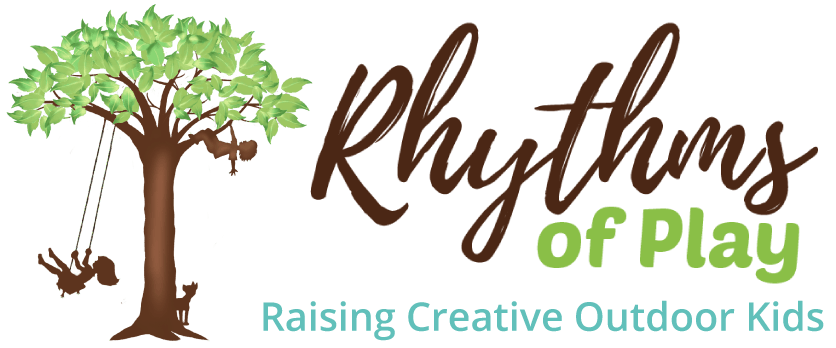
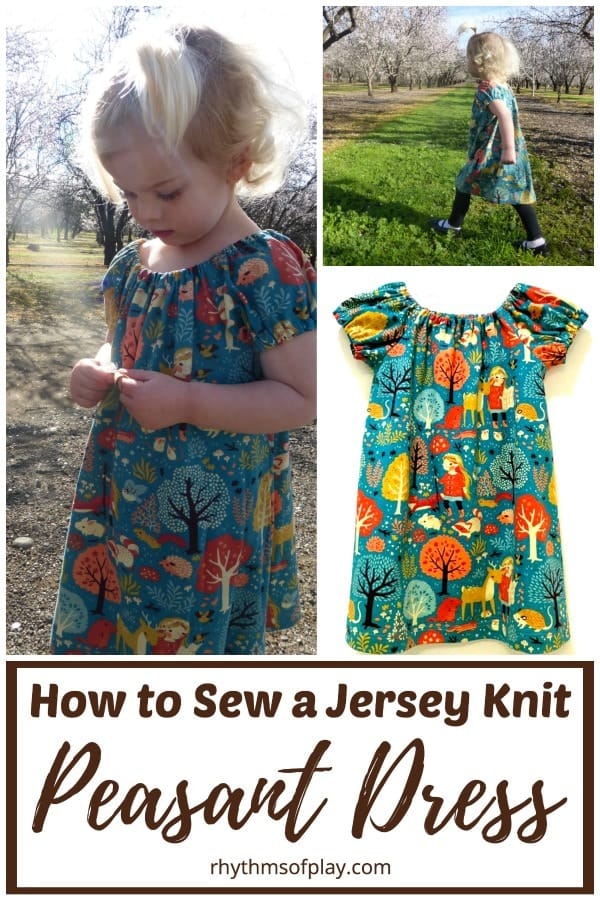
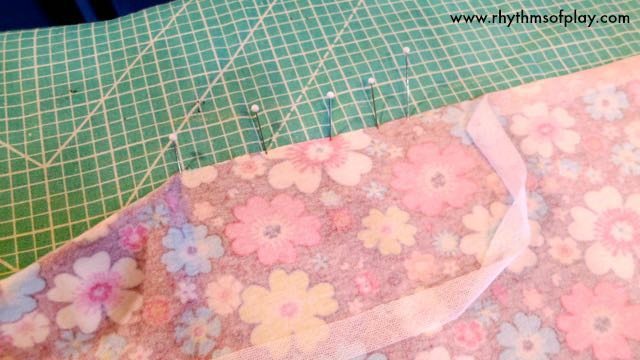
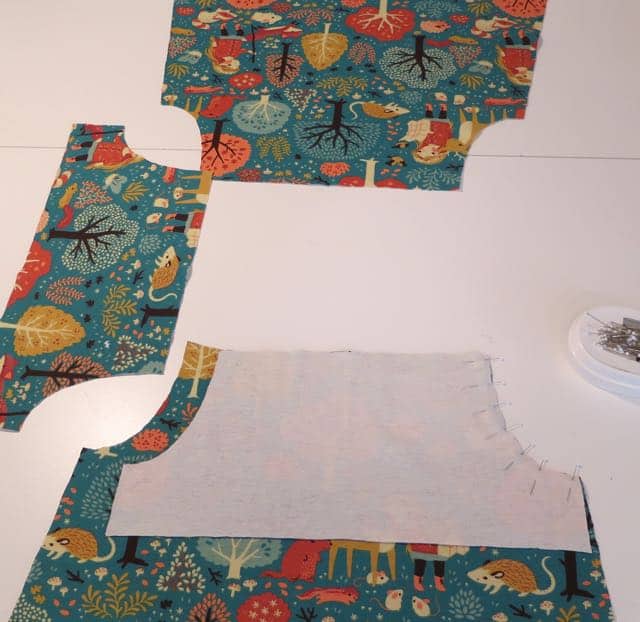

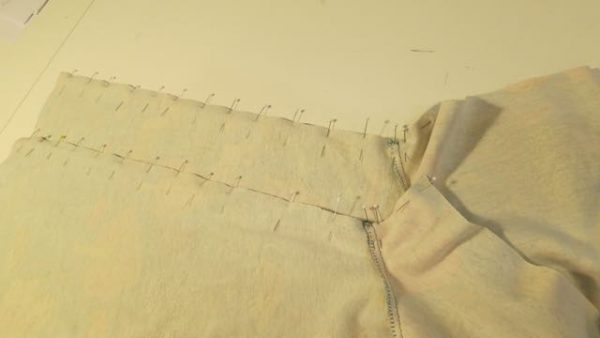
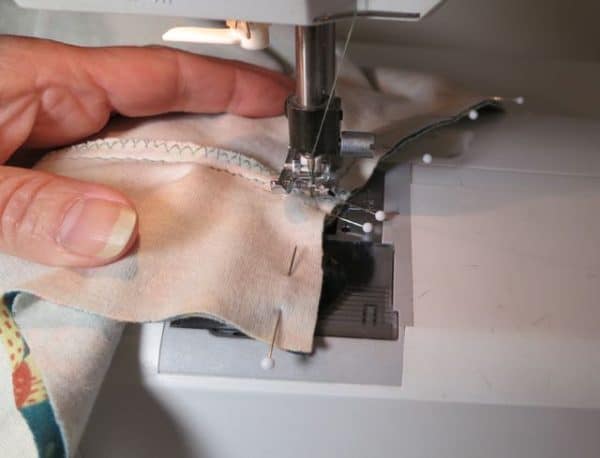
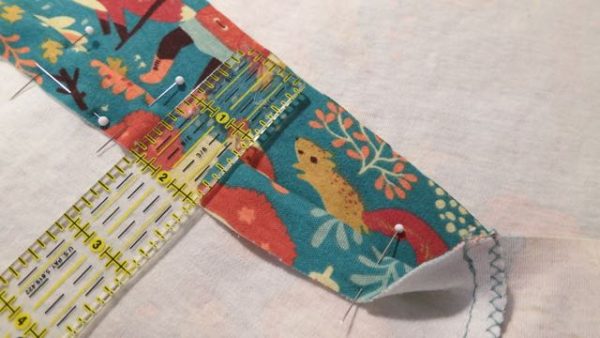
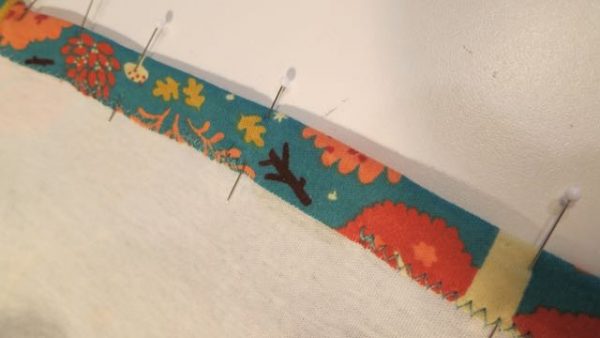
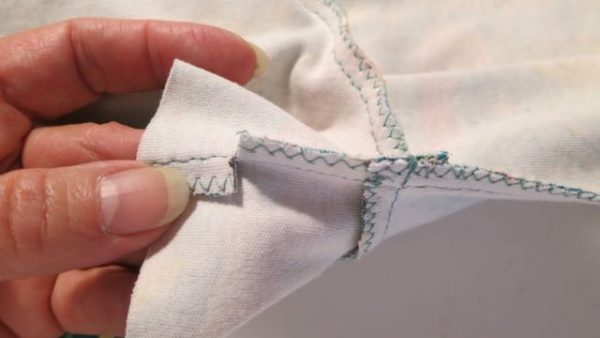
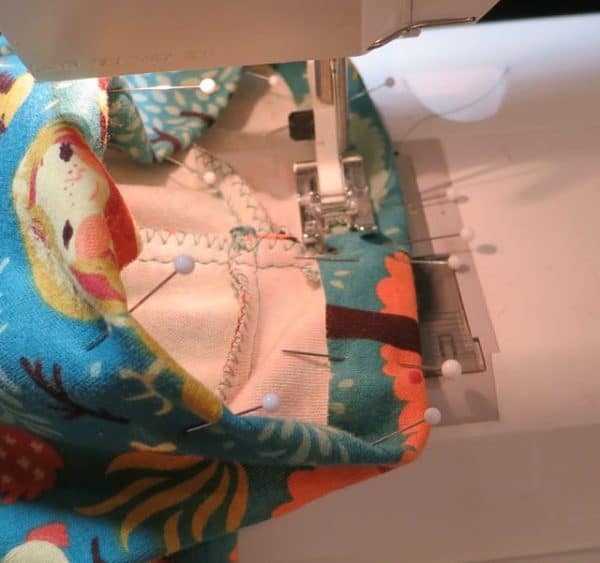

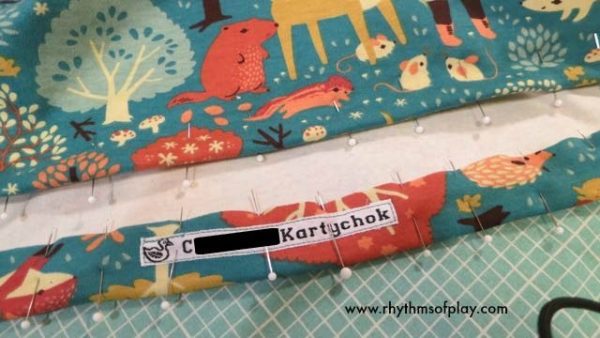
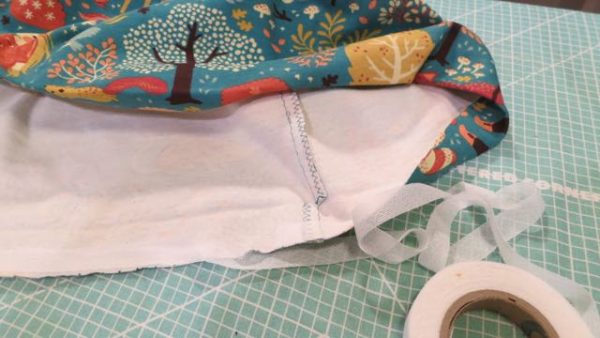


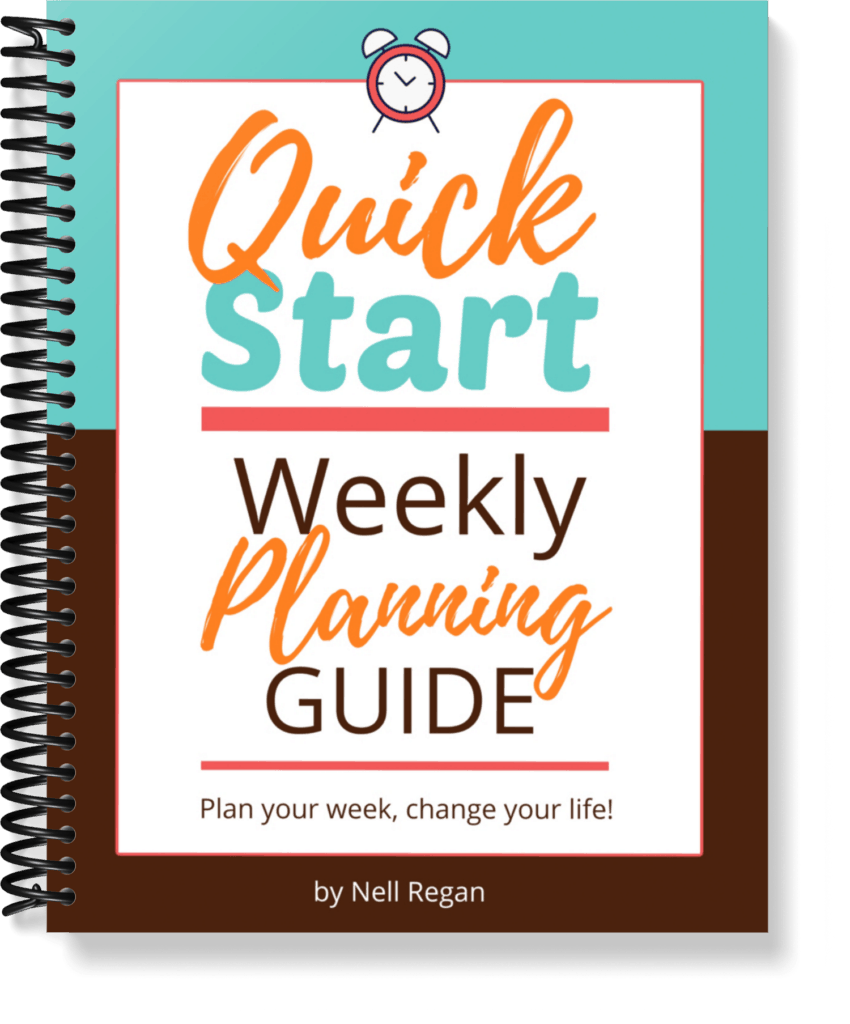
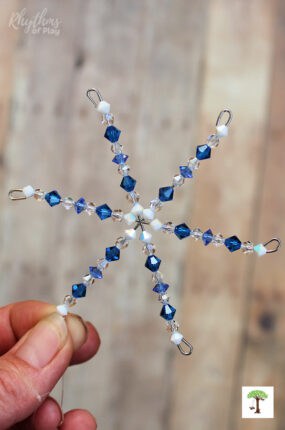
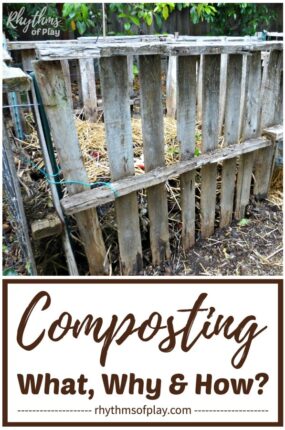
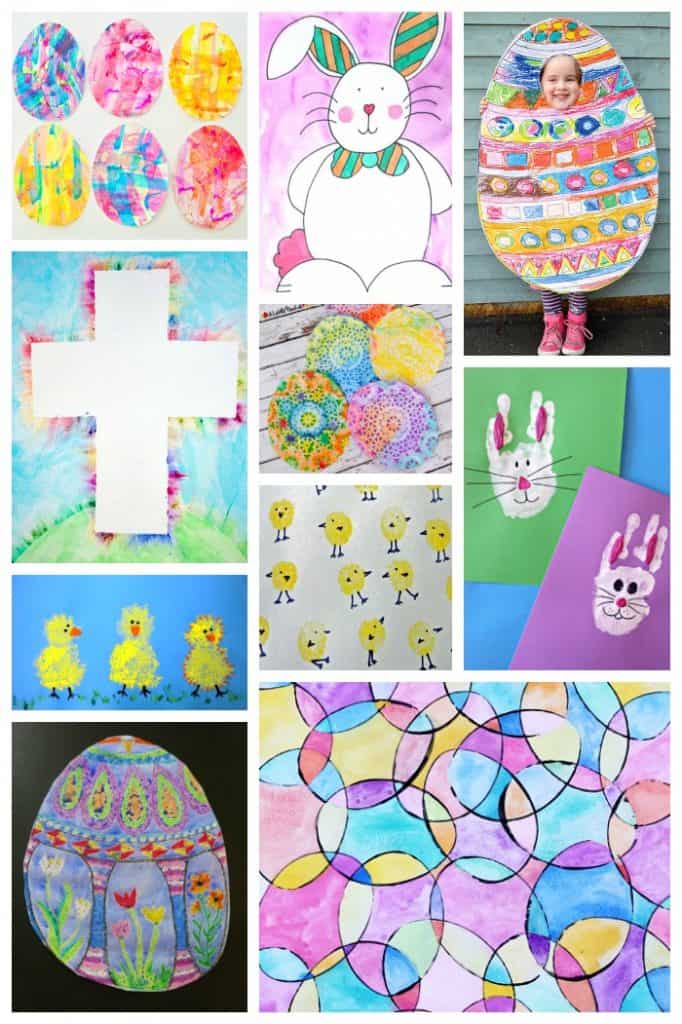

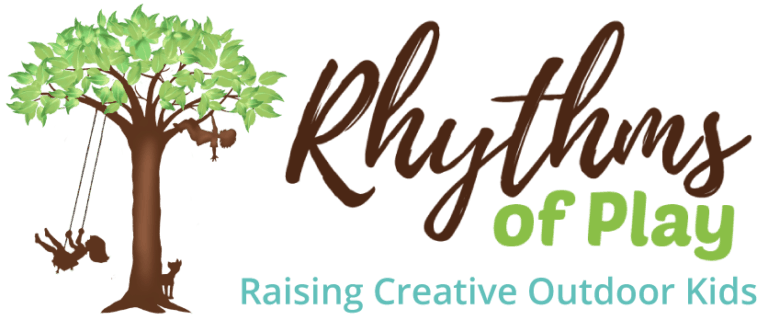
I absolutely love this post! Thanks so much for putting it together Nell and Harriet! I am bookmarking, pinning, and marking as a favourite! Thanks Thanks!
You are very welcome! We had fun collaborating together — your enjoyment makes it all worthwhile 🙂
This is very pretty! You are talented!
Thanks Melissa I agree… she is very talented. That’s why I had to share 🙂
LOVE this! I’m so going to make this, thanks for sharing! And I really really like the fabric you used!
Thanks Ann! I’m so glad you like it 🙂
I love that woodland print. Very cute.
Were do you find the Jersey Knit fabric?
Hi Wanda! I just noticed that the link I had in this post to the jersey knit fabric my step-mother used has expired. I would recommend purchasing 100% cotton jersey knit, which you can find by the yard at this Amazon affiliate link: https://amzn.to/2pklr1W. You can also find cotton jersey knit fabric at fabric sewing, and quilting stores. Good luck!